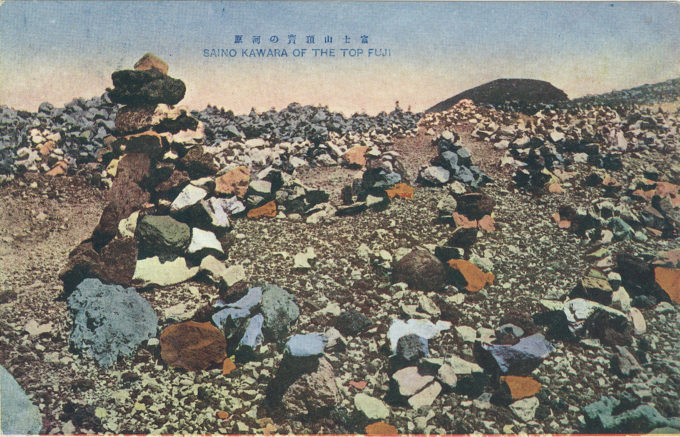“‘But why are those little stones piled about the statues?’ I ask.
“Well , it is because some say the child-ghosts must build little towers of stones for penance in the Sai-no-Kawara, which is the place to which all children after death must go. And the Oni, who are demons, come to throw down the little stone-piles as fast as the children build; and these demons frighten the children, and torment them.
“But the little souls run to Jizo, who hides them in his great sleeves, and comforts them, and makes the demons go away. And every stone one lays upon the knees or at the feet of Jizõ, with a prayer from the heart, helps some child-soul in the Sai-no-Kawara to perform its long penance.”
– Glimpses of Unfamiliar Japan. Vol. 1, by Lafcadio Hearn, 1894

“Sai-no-Kawara of the top [of Mt.] Fuji”, Japan, c. 1930. In Buddhist mythology, children who die as infants or are stillborn are not permitted to ascend to Paradise because their early death brought great sorrow to their parents. Their souls instead go to Sai no Kawara, a riverbank littered with many stones and pebbles, and considered to be the river flowing at the boundary between life and the afterlife. Such children can cross the river into Paradise only after piling stones and pebbles to atone for the sorrow their early deaths brought to their parents. One can find many locations around Japan where stone piles are raised as random, symbolic Jizo shrines.
See also:
Jizo temple at Asakusa Park, Tokyo, c. 1910.
Views of Mt. Fuji, c. 1910-1950.
“Another legend, Sai-no-kawara, illustrates more directly the relationship between Jizo and children; it shows the folk belief in Jizo as a protective deity of children. This legend also demonstrates that Jizo not only protects living children but also saves the souls of young children who have died.
“Sai-no-kawara is a riverbank, a marginal place between the worlds of the living and the dead. It is believed that all children who die under ten years of age gather at the banks of the Sai River where they pile up stones for their living parents, reciting prayers for them. The legend of the Sai-no-Kawara gives us an idea of the close relationship between Jizo and children.
“The summary of the legend as follows:
‘At the riverbank, which lies between the world of living and the world of the dead, little children were piling stones to make towers, saying, ‘The first stone is for the happiness of my father, the second stone is for the happiness of my mother, and third stone is for the happiness of my brothers and sisters.’
‘But as the sun went down, a demon appeared and destroyed the stone towers with an iron stick and ordered the children to pile them up again. At that very moment Jizo appeared with the night breeze.
‘Telling the children that he would protect them like a father and mother in the other world, he compassionately held them within his robe, letting them sleep in peace …’
“As this legend illustrates, Jizo’s main characteristic is that of a merciful protector of children.”
– “Jizo-bon in Kyoto Today: A Celebration of Children and Community”, by Miyuki Hirayama, The Children’s Folklore Review, 2006-2007


Pingback: “The Tengu rock, Mt. Bandai”, Fukushima Prefecture, c. 1920. | Old Tokyo
Pingback: “Thirty-Six Children beside the steps to the Head Temple”, Mt. Takao, Hachioji, Tokyo, c. 1930. | Old Tokyo